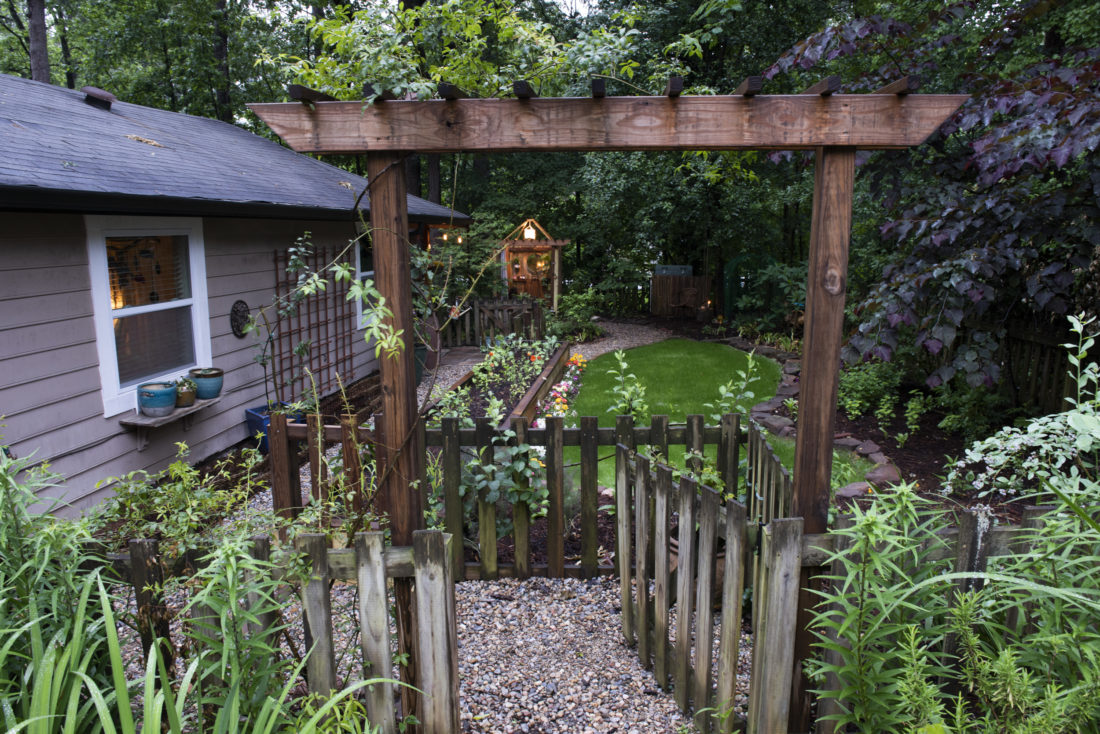Got a lawn full of clover? You’re doing it right. Put off mowing? Well done, you. “Less is more” is the mantra of Brandy Hall, the founder of Atlanta’s Shades of Green Permaculture, which builds regenerative landscapes for homes, businesses, farms, and schools. Part of a new guard of landscape designers, Hall is keenly aware of the environmental downsides of conventional practices: gas-powered lawn equipment and synthetic fertilizer that drive climate change; herbicides, pesticides, and fungicides that deplete soil microbes, harm pollinators, and pollute waterways.
But while some sustainability proponents demonize turfgrass and the general ideal of a manicured yard, Hall understands the desire for a patch of well-tended greenspace. “There is something to be said about the visual organization and serenity an open space can invoke,” she says. “How do we do that in a way that’s not causing harm?”
Hall shares five ways to reduce such harm on and around your lawn, and great news, they all involve doing less.

1. Embrace a weedy lawn (it’ll be okay)
Rare is the plot of land that caters to a single type of grass. (If yours is perfectly flat with uniform sunlight and zero tree roots, you probably don’t live in the South.) Follow Hall’s advice—and the path of least resistance—and cultivate a mixed-species lawn. “If you look to nature, you’ll rarely find a single-species anything, even a stand of trees,” she says. “Diversity is key to a happy ecosystem.”
To preserve a sense of lawn-ness, Hall suggests seeding with fescue (an evergreen perennial grass; she likes Pearl’s Premium) and allowing weeds to fill in gaps. “In an area that’s a little more moist and shady, you might have clover doing well, and in the dry part of the yard maybe it’s the fescue mix, but in both cases you have something green and alive,” she says.
If your inner Augusta National admirer is struggling to get on board, try rebranding weeds as “friends with benefits.” Hall ticks off the perks of three common Southern lawn intruders: Clover is a nitrogen fixer, which means it extracts nitrogen from the air to the benefit of surrounding plants, while dandelion and broadleaf plantain are “dynamic accumulators” that draw nutrients from deep in the soil and redistribute them. (In folk medicine, dandelion is also a liver tonic, while crushed plantain soothes insect stings; chew up a leaf and put it on the spot for a quick salve—and cookout party trick.)
2. Mow half as often
You already know that overzealous mowing can stress your grass in the heat of a Southern summer. Close-cropped lawns are also generally terrible for the environment. Gas-powered yard equipment accounts for 5 percent of all air pollution in the United States, according to the EPA. When turfgrass is shorter than three inches, Hall notes, about 85 percent of the rain runs off, taxing stormwater systems. (Yet another reason to welcome weeds to bare spots.)
Hall herself only mows once a summer but understands that may be too laissez-faire for some. Her advice: “Let it grow just a little bit. If you mow weekly, switch to biweekly. If you mow biweekly, switch to every three or four weeks. It’s still manicured; it’s not going to flower.”
Then again, if you don’t mind a few flowers in your lawn, the honeybees will thank you. (Small children like them, too.)
3. Keep your leaves
Of all the landscaping practices Hall finds absurd, bagging leaves—which are full of stored nutrients and minerals—ranks at the top. You know the drill: “Instead of letting them decompose, we use carbon-heavy small-engine blowers to blow them into a big pile, then put them in plastic or plantation-pine-pulp bags and set them on the curb. That then gets hauled to a landfill on a big diesel truck, where it’s just going to turn into methane and cause greenhouse gasses,” she says. “Then you go to the store in spring and buy compost, which is the exact nutrients you hauled off six months ago.”
Fix the broken loop: Let fallen leaves lie—or rake them to the side, let them decompose, and redistribute them later.
4. Hold off on “deadheading”
Another needless filler of lawn bags, according to Hall, are dead stalks and flowerheads that people tend to prune in the name of tidiness. Never mind the color and texture possibilities of dried vegetation; dead things have utility beyond aesthetics. “If we leave seed heads, that becomes forage for different types of songbirds,” she says. “Standing dead parts of a plant become a habitat in the winter for beneficial insects.”

5. Let it bloom where it’s not planted
People feel compelled to keep plants in the exact spot they were planted, Hall says—“‘Oh, it’s taking over this. It’s popping up over there.’” Perennial plants, in particular, tend to travel, especially those with runners such as black-eyed Susan, mountain mint, and strawberries. She recommends creating structure through plants like compact evergreens and bunching grasses, then letting nature take its course. “The product is plants that are thriving,” she says. And a lot more free time.








